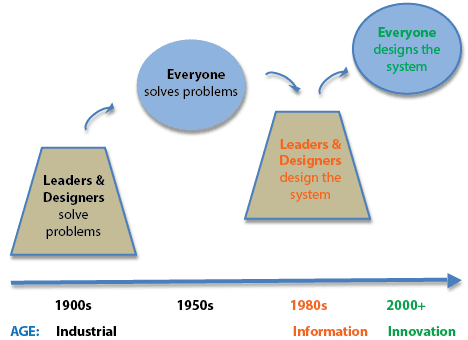When we picture a collaboration platform, our mind typically moves to such technology software housed on our computers as enterprise and customer/sales resource planning systems — ERPs or CRMs, SharePoint, Google Apps, GoToMeeting, etc. Many organizations implement these software tools with little or no customization to their enterprise’s unique social fabric — culture and values. In other words, the enterprise’s social system (its people and their interaction patterns with others) is superseded by the technical system (computers and other equipment). Instead of the computer software being a work tool to aid its operator, it increases the amount of work no longer adding value for either the operator or customers. After decades of research, we now know that ignoring the social needs of an organization and only considering its technical needs creates an imbalance in organizational functioning. This dysfunction is one of the reasons for our evolution from the Industrial and Information Ages into the Innovation Age.
Another reason for these paradigm shifts over the past century is what some colleagues are calling the emerging ethos of collaboration. Our increasingly interconnected and interdependent world is no longer nurtured by competition and conquest. Furthermore, our ability to solve the wicked problems of today’s world relies on the continuous learning, shared purpose, harmonious values and active cooperation of interested groups of people. In other words, innovative ways and means for enriching life on this planet necessitate full engagement of our interdependent organizational and global social systems.
So how do we go about orchestrating such full-scale human engagement . . .
• by design;
• by being purposeful about our design choices;
• by not letting one system’s dynamics (i.e., the technical) supersede those of the other
systems (i.e., social, environmental);
• by collaboratively designing with all affected stakeholders.
In the arena of socio-technical systems design, practitioners and their organizational clients collaboratively design humane, healthy, innovative systems — business models, teams, enterprises, networks and ecosystems — to optimize core efficiencies and innovate new solutions. Very recently, a team of STS designers created the model below to visually illustrate the holistic framework within which organizations operate.
STS Collaboration Platform

Source: STS Inter-organization Model Design Team (Doug Austrom, Hakim Benichou, Don de Guerre, Laura Jacobs, Seth Maenen, Betsy Merck, Carolyn Ordowich, Peter Sorenson (2014)
In the centre of the model is the system to be designed with its three major elements — purpose, social system, technical system — each outlined as a continuum. Surrounding the system is its background context, which in STS design promotes symbiotic partnerships —
Humanistic values of free will, autonomy, challenge, mastery, community, purpose and reciprocity.
Participative democracy principles where everyone senses, learns and acts on events as they emerge.
Adaptive planning to collaboratively create system maps, analyze stakeholder networks, build culturally desirable scenarios, test hypotheses and prototype new models.
Non-bureaucratic organization structures and systems that empower and grow systems and relationships into solution generation rather than imposing the solutions.
At the core of this STS Collaboration Platform are the cross-functional teams who design what work to do and how to do it constituting a radically decentralized, shared leadership governance structure. By articulating the salient design choices, the model above facilitates collaborations based on STS shared values of people, purpose, planet and prosperity. As a result, the quality of the organization and the quality of work life improve simultaneously due to the collaboration and conscious design choices of the participating organizations.
How can you begin to bring both forms of quality into your working world?
For more on personal and organizational transformation, click here.






